
The Nordavinden is a newly released bicycle model from the small West-Coast company Rawland Cycles. Earlier this year I featured a friend's Rawland rSogn, which I could not ride because it was too big. At the time Rawland did not make a bike in my size, but they informed me that one would be coming out later in the year. We talked about a test ride, and as luck would have it, a demo bike was ready just before D2R2. I had it in my possession for a nice long weekend - most of it spent riding local and not so local dirt roads.

Norwegian for "the north wind," the Nordavinden was designed as a lighter, sportier frameset than its more rugged predecessors: a zippy bike with low trail geometry that accepts fat tires. Full geometry and tubing specs are available here. Like all Rawland models, the Nordavinden is designed in California and handbuilt in Taiwan.
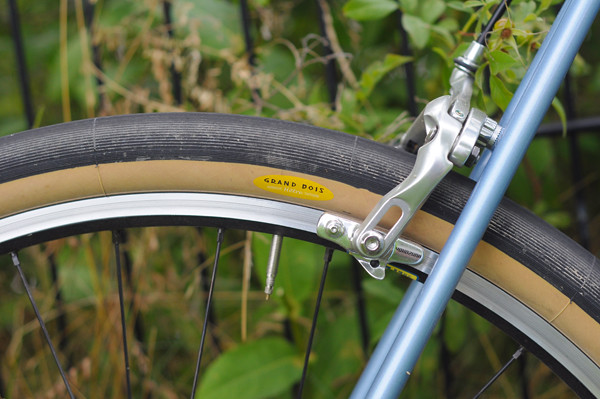
The larger sizes are built for 700C and will fit a tire up to 35mm. The small size is built for 650B and will fit a tire up to 42mm (pictured here with Grand Bois Hetres).
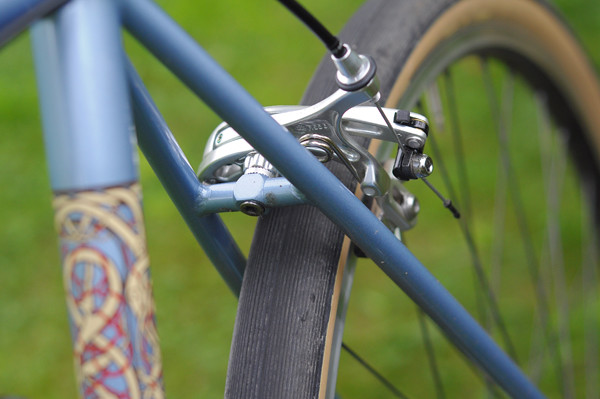
The frame is designed for sidepull or centerpull brakes. The demo bike came fitted with Rivendell's (discontinued) Silver big-mouth sidepulls.

The dramatic curvature of the fork is immediately noticeable - prompting lots of low trail questions from those who saw the bike whilst in my possession. The trail is 30mm,with 650Bx42mm tires.

Unlike its predecessor rSogn's double plated crown, the Nordavinden's fork crown is the more minimal Pacenti Artisan II, with lighter fork blades.

The "ice blue" paint is a light, shimmery sky-blue. I tried to take some pictures that eliminated the shimmer and showed the true colour underneath. In person, the shimmer makes the blue look lighter. Compared to the (very similar) colour of the rSogn, the Nordavinden is cooler and a bit more saturated.

Looking at the Nordavinden next to the rSogn (front), they are similar at first glance, but less so upon closer inspection. The Nordavinden has an almost level top tube (1.5° slope), compared to the rSogn's more prominent slope. The Norvavinden's appearance is sleeker and more roadish - with fewer braze-ons, narrower tire clearances, lower bottom bracket, shorter chainstays.
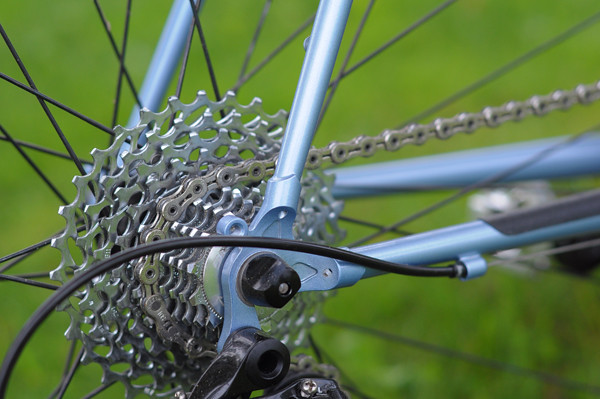
Still, the Nordavinden is sufficiently versatile, with eyelets for fenders and braze-ons for a front rack (on the fork blades; optimised for Rivendell's Nitto Mark's rack).

The frame itself is welded cro-moly steel, with some decorative flourishes.

A Rawland chain-slap protector is included with the frame set,
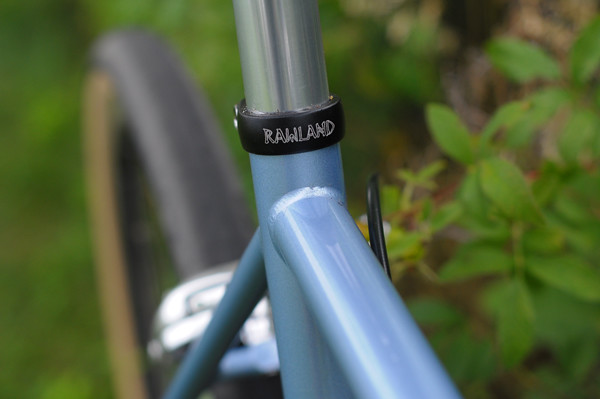
As well as a Rawland seat collar.

The size Small is described as a 54cm frame, measured by its top tube. My ideal frame size for a road fit would have a 53cm top tube, but the small Nordavinden worked nicely with a slightly shorter stem.

Rawland advertises no toe overlap in any of their frame sizes. This held true for me (in size 38 clipless shoes), with room for a fender.

The demo model was built up with Velocity Synergy rims, White Industries hubs, a SRAM Apex drivetrain,

Chris King headset, Soma threadless stem and handlebars, Tektro short reach brake levers and bar-end shifters. The build was not done for me specifically, but I did have a say in stem length and handlebar width, to ensure the bike would fit me. Were this my own bicycle, I would do some things differently for sure. But sometimes it can be interesting to use unfamiliar components.

For shifters, I had a choice between SRAM brifters and bar-ends, and opted for the latter. Prior to this I had not used bar-end shifters in over a year, and it took me a bit to free my brain from Campagnolo ergo mode. By the end, the SRAM bar-ends grew on me, though I still prefer Campagnolo ergos on my own bike.

I used my own pedals and saddle, and installed two bottle cages. The bike did not come equipped for carrying a front load, as it was optimised to do, so I used a saddlebag when I needed to carry a camera and other items.The bike - as shown here, but without bag and water bottles - weighed just over 24lb.

I rode the Rawland Nordavinden for a total of 150 miles over the course of 4 days. First was a 30 mile shake-down ride, which included 12 miles of local dirt roads. The following day, I rode a 50 mile route at the D2R2, over half of which was dirt. The day after, I did a 40 mile local ride that included a paved road, a dirt road, and a rather technical dirt trail. And after that, I did a final 30 mile ride on paved roads - including a couple of hill climbs - before returning the bike.
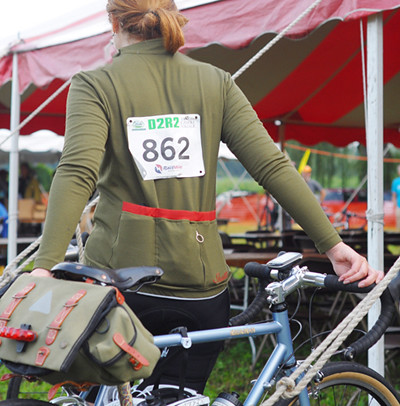
What I noticed about the Rawland immediately, was that my sense of balance was different on it than on other roadbikes I've ridden recently. I found tight cornering easier than it typically is for me, and I found it surprisingly easy to change my position on the bike without disturbing its balance - allowing me the freedom of activities I usually have trouble with, such as drinking from the water bottle while riding. I remember similar handling when riding the Royal H. Randonneur last summer, but this time I think I was able to appreciate it more - particularly on unpaved terrain. At the D2R2, I was able to descend on loose dirt and gravel faster than I was comfortable doing previously, and to drink all the water I wanted without having to stop. It certainly added to my enjoyment of the day. The following morning, I rode unceremoniously on a somewhat challenging local dirt trail that I've never been willing to ride before.
 As far as speed, the Rawland is plenty fast and accelerates with no hesitation. There is a snappy, responsive, roadish feel to it. On pavement it is not quite as fast as my Seven roadbike, and it does not climb quite as effortlessly. But as soon as the pavement ends, the dynamic changes. It's as if the two bikes were made to be friends and supplement each other. The Rawland glides over dirt and gravel, seemingly preferring them to pavement. In part, of course, it is t
As far as speed, the Rawland is plenty fast and accelerates with no hesitation. There is a snappy, responsive, roadish feel to it. On pavement it is not quite as fast as my Seven roadbike, and it does not climb quite as effortlessly. But as soon as the pavement ends, the dynamic changes. It's as if the two bikes were made to be friends and supplement each other. The Rawland glides over dirt and gravel, seemingly preferring them to pavement. In part, of course, it is the wide tires - which don't bounce me around the way narrow road tires do. But it's also the handling -again, that peculiar flavour of maneuverability that comes with low trail - that makes it easy for me to pick a line through rutted out areas and to corner on loose sections without reducing speed.
On a bike with standard front end handling, I feel less confident riding on winding, unpaved roads and trails - especially descending. This preference might be particular to me, I don't know. But I found the Rawland's handling exceptionally agreeable for riding on dirt.
Notably, carrying weight in the rear was not a problem despite the bike's low trail design. It did not feel much different than riding without a saddlebag, except on steep climbs (with a full saddlebag, the front end "wandered" a bit). I do not know what the bike feels like to ride with a handlebar bag, but I can only imagine that not worse, considering that it's designed for one. I should also point out that I do not know what the bike feels like to ride long distances; my longest single ride on it was only 50 miles. With its front rack braze-ons, a bike like this just begs to be taken on a long, self-supported ride, and I hope to soon read some reviews from owners who've done that.
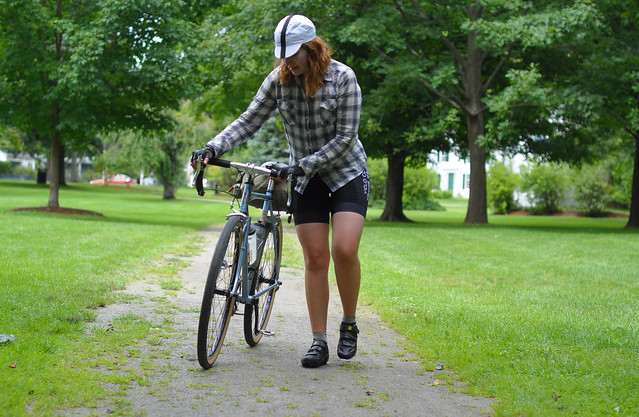
To think of criticisms is not an easy task here. I suppose I would like the bike even better if it were lighter, though I recognise the weight is pretty good for a bike of its kind. Anotherthing I can say is that I am fairly spoiled at this point as far as ride quality, and from that perspective the Rawland is not the cushiest bike I've ever ridden. It isn't a harsh ride by any means, but I feel that much of the cush is due to the fat tires - and that with narrower ones I would feel the bumpy roads more. Finally, as I've mentioned already,on pavementthe Rawland is not as fast as my Seven - but then I don't think it makes sense to pit them against each other; they are not meant for the same kind of riding. I would not mind owning a bike like the Rawland to supplement my skinny tire roadbike.
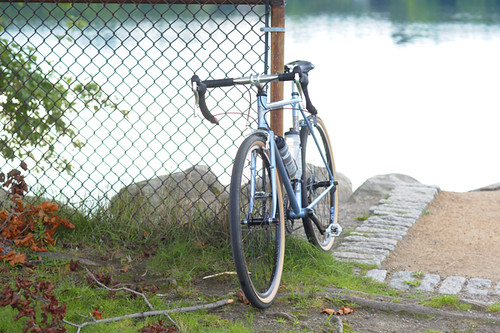
While showing off the demo bike, more than a couple of times I was asked why only the smallest Nordavinden size is offered in 650B. I must say I wonder as well, as it is precisely the combination of the wide 42mm Grand Bois Hetre tires and the handling that draws me to the bike. There is demand out there for lightweight, sporty low trail 650B bikes without having to spend a fortune on custom work. The Rawland Nordavinden retails at $725 for the frameset (available from Rawland Cycles directly). While I cannot vouch for the other sizes, I suspect the 650B Nordavinden is a bike that many would appreciate for road-to-trail riding.
Many thanks to Rawland Cycles for loaning out the demo bike, and thanks to the Ride Studio Cafe for putting it together.
More pictures here.
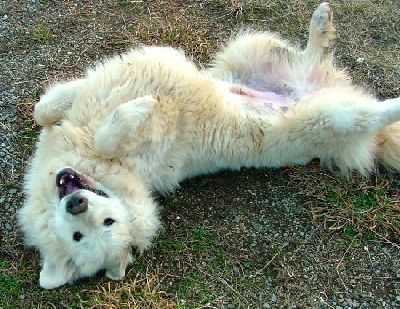















 The structure on the left is the largest that is still standing. In the middle is what they called Boulder House, and on the right are several other ruins, including Tilted Tower (behind the small building). The National Park Service uses the nomenclature of “house” for many of the buildings but, in fact, the actual use or purpose of the structures is not known.
The structure on the left is the largest that is still standing. In the middle is what they called Boulder House, and on the right are several other ruins, including Tilted Tower (behind the small building). The National Park Service uses the nomenclature of “house” for many of the buildings but, in fact, the actual use or purpose of the structures is not known. From across the canyon are the same three buildings as in the first picture. Boulder House is on the far right.
From across the canyon are the same three buildings as in the first picture. Boulder House is on the far right.

 Detail of the foundation of Boulder House.
Detail of the foundation of Boulder House. The structure on the left is called Tilted Tower, for obvious reasons. Sometime after the Ancestral Puebloan people left, the sandstone boulder it was built upon shifted and slipped sideways into the canyon. The upper stories of the tower fell on the boulder and into the canyon. To me, the incredible thing is that even a portion of it remains standing.
The structure on the left is called Tilted Tower, for obvious reasons. Sometime after the Ancestral Puebloan people left, the sandstone boulder it was built upon shifted and slipped sideways into the canyon. The upper stories of the tower fell on the boulder and into the canyon. To me, the incredible thing is that even a portion of it remains standing. Tilted Tower. It almost looks like someone came along with a gigantic saw and cut the end off of that boulder!
Tilted Tower. It almost looks like someone came along with a gigantic saw and cut the end off of that boulder! Weeping Rock - so porous that water seeps through it and a variety of plants grow on its walls.
Weeping Rock - so porous that water seeps through it and a variety of plants grow on its walls. Along the river were many trees with oddly shaped roots. This one wasn't too far from my campsite.
Along the river were many trees with oddly shaped roots. This one wasn't too far from my campsite. On the eastern side of the park, through a tunnel (a marvel of engineering completed in 1930) is Checkerboard Mesa.
On the eastern side of the park, through a tunnel (a marvel of engineering completed in 1930) is Checkerboard Mesa. And the eastern side is also where you might see Bighorn Sheep. I was lucky and saw several on this day. (I wasn't very close, these were taken with the 7x zoom magnification.)
And the eastern side is also where you might see Bighorn Sheep. I was lucky and saw several on this day. (I wasn't very close, these were taken with the 7x zoom magnification.)
 Of course, spring flowers were in bloom. Not covering massive areas (as in California) but quite a few scattered here and there, and in the most unusual places. Like on the side of a canyon wall or in the crevice of a rock.
Of course, spring flowers were in bloom. Not covering massive areas (as in California) but quite a few scattered here and there, and in the most unusual places. Like on the side of a canyon wall or in the crevice of a rock.
 There was only one thing (and lots of that one thing) that even slightly marred my stay at Zion National Park. Worms. Though technically I guess they were caterpillars. They were creepy, crawly things. Lots of them. And they really liked my red tent. I mean, really. Every morning and every night and whenever I'd notice them, I'd pick them off the outside of the tent, 10 or 15 at a time.
There was only one thing (and lots of that one thing) that even slightly marred my stay at Zion National Park. Worms. Though technically I guess they were caterpillars. They were creepy, crawly things. Lots of them. And they really liked my red tent. I mean, really. Every morning and every night and whenever I'd notice them, I'd pick them off the outside of the tent, 10 or 15 at a time. The Sierra Madre Mountains as seen from near Pine Mountain Summit. Elevation was more than 5,000 feet.
The Sierra Madre Mountains as seen from near Pine Mountain Summit. Elevation was more than 5,000 feet.



 One of the wildflowers found along the bluff trail.
One of the wildflowers found along the bluff trail.
























